Hydroelectric dams, while essential for energy production, pose substantial controversies for ecosystems due to their significant disruption of natural river systems. They impede sediment transport, altering water quality and creating barriers that hinder migratory fish species like salmon. This leads to habitat fragmentation and biodiversity decline, with studies showing that dams have negatively impacted populations in several regions. Moreover, the construction of reservoirs often results in extensive land loss, displacing communities and disrupting habitats. Additionally, greenhouse gas emissions from these reservoirs can exceed those of fossil fuels, complicating the narrative of clean energy. To explore further implications, we can examine specific case studies.
Key Takeaways
- Hydroelectric dams disrupt sediment and nutrient flow, essential for maintaining healthy freshwater ecosystems and aquatic life.
- Dams create barriers that fragment migratory fish populations, limiting their access to critical spawning grounds.
- Reservoir creation causes significant land use changes, leading to habitat loss, deforestation, and agricultural damage.
- Large dams displace millions of people, resulting in social upheaval and negative impacts on food security for affected communities.
- Hydroelectric projects can emit greenhouse gases, often exceeding emissions from fossil fuel plants due to decaying vegetation in reservoirs.
Impact on River Ecosystems
When we think about the impact of hydroelectric dams on river ecosystems, it's clear that the consequences are far-reaching. Hydroelectric dams greatly disrupt the natural flow of sediment and nutrients, which are essential for maintaining healthy freshwater ecosystems. This alteration can degrade water quality and change habitats, making it difficult for aquatic organisms to thrive. Moreover, migratory fish, like salmon and shad, face obstructions that hinder their reproduction and lifecycle. The stagnant reservoirs created by dams can foster harmful algae blooms, leading to oxygen depletion and a decline in biodiversity. Additionally, the flooding associated with dam construction results in the loss of crucial forests, wildlife habitats, and agricultural land, affecting the ecological balance and the livelihoods of millions who depend on these ecosystems.
Fish Migration Challenges
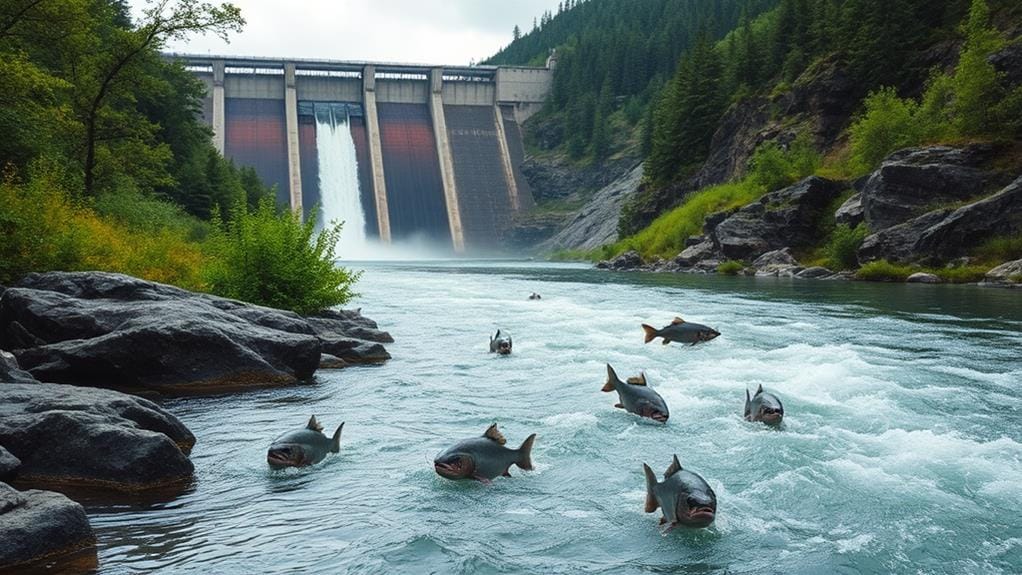
Hydroelectric dams pose significant challenges to fish migration, particularly for species like salmon and shad that depend on unobstructed pathways to reproduce. These structures create barriers that fragment migratory fish populations, limiting their access to important spawning grounds. While fish ladders have been designed to facilitate movement, they often fall short of effectively supporting the complex needs of these species. Dam projects, such as the Sambor dam in Cambodia, threaten critical habitats, exacerbating ecological consequences and jeopardizing fish populations. Studies indicate that the seven dam sites on the Xe Kong River further illustrate the detrimental impact of hydropower development on biodiversity. As we navigate these challenges, it is imperative to prioritize sustainable solutions that protect our aquatic ecosystems and the communities that rely on them.
Land Use and Habitat Loss
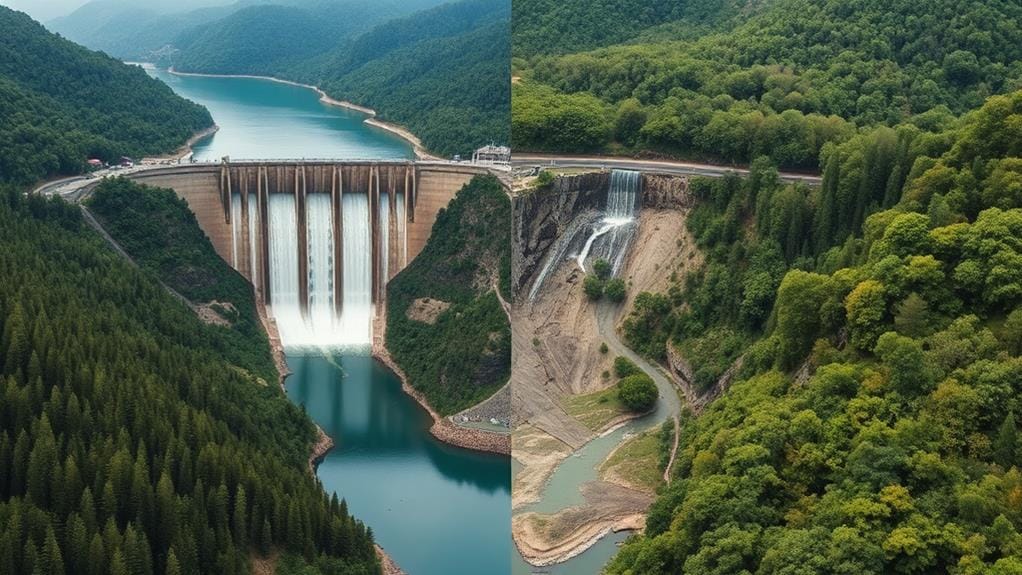
As we explore the impacts of hydroelectric dams, it's essential to take into account the extensive land use changes and habitat loss these projects entail. The creation of reservoirs not only results in the flooding of vast areas, as evidenced by the Balbina Dam's inundation of 2,360 square kilometers, but also fragments habitats, disrupting local wildlife and ecosystems. Additionally, the displacement of communities, with estimates ranging from 40 to 80 million people affected globally, highlights the human cost associated with these energy developments.
Reservoir Flooding Impacts
The creation of reservoirs for hydroelectric dams can lead to significant land use changes and habitat loss that profoundly affect local ecosystems. Reservoir flooding often inundates large areas, such as the Balbina Dam in Brazil, which flooded 2,360 square kilometers to generate just 250 MW of capacity, resulting in extensive land loss. This flooding destroys forests, agricultural lands, and essential habitats, diminishing local biodiversity and threatening food security. Additionally, the alteration of land use disrupts ecosystems, degrading water quality and promoting harmful algae growth due to stagnant conditions. The displacement of 40 to 80 million people globally further exacerbates these issues, as communities lose their homes and livelihoods, creating a ripple effect that impacts both human and ecological systems.
Habitat Fragmentation Issues
Habitat fragmentation poses a significant challenge to both terrestrial and aquatic ecosystems, often resulting from the construction of dams. These structures disrupt natural river systems, leading to significant alterations in habitat connectivity, which affects wildlife populations. When dams block the flow of crucial sediments and nutrients, we witness a decline in ecosystem health and biodiversity downstream. Furthermore, migratory fish species, such as salmon and shad, face severe obstacles as their natural migration routes are obstructed, hindering their reproductive success. Studies reveal that existing dams have fragmented tributary networks across six of the eight major Andean Amazon basins, fundamentally changing the ecological landscape. As we navigate these issues, it is critical to reflect on the long-term repercussions on our ecosystems and the species that inhabit them.
Community Displacement Concerns
Constructing large hydroelectric dams often leads to severe community displacement, fundamentally altering the landscape of human habitation. The necessity for expansive reservoirs results in significant land use changes, as evidenced by the Balbina Dam, which flooded 2,360 square kilometers. This flooding not only obliterates forests and agricultural land but also disrupts local ecosystems, leading to long-term ecological impacts. Approximately 40-80 million people have been displaced, causing profound social impacts and severing cultural connections tied to ancestral lands. Additionally, the submergence of archaeological sites diminishes cultural significance, while altered water flows negatively affect downstream communities, with an estimated 472 million individuals facing reduced food security. Such multifaceted consequences underscore the need for careful consideration of hydroelectric projects.
Greenhouse Gas Emissions

Greenhouse gas emissions from hydroelectric dams are often overlooked in discussions about renewable energy. While hydropower is positioned as a sustainable alternative, the reality reveals significant environmental impacts. Reservoirs can emit greenhouse gases at rates surpassing fossil fuel plants, primarily due to decaying vegetation and stagnant water conditions. For instance, methane—over 80 times more potent than CO2—contributes to 25% of global warming, with emissions from poorly planned hydropower projects in tropical regions exceeding 0.5 lbs CO2 equivalent per kWh. Additionally, the lifecycle emissions from large semi-arid dams average around 0.06 lbs CO2 equivalent per kWh, emphasizing the need for careful planning and consideration of the true climate costs associated with hydropower initiatives.
Social and Human Rights Issues
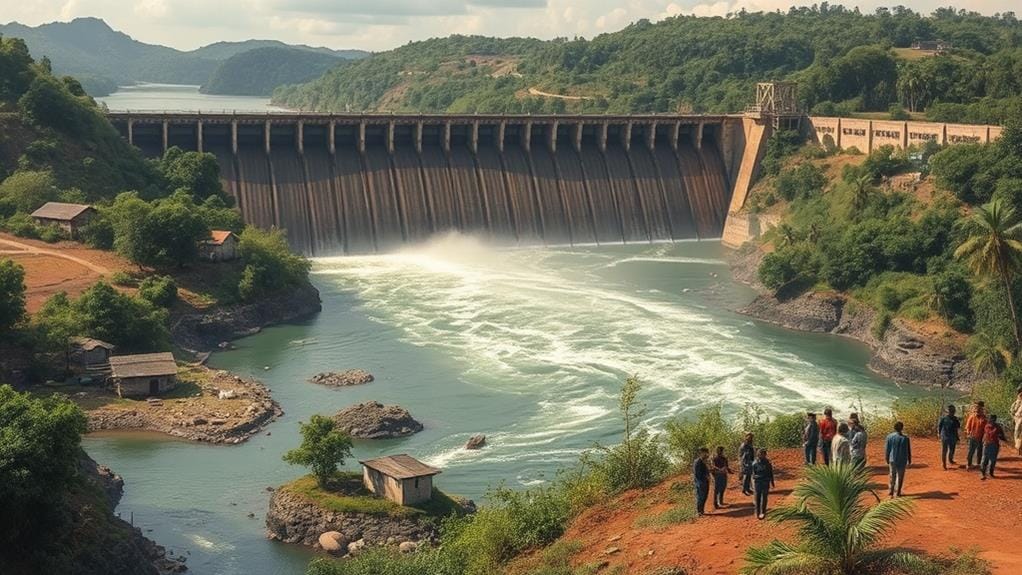
While the environmental impacts of greenhouse gas emissions from hydroelectric dams are significant, the social and human rights issues surrounding these projects deserve equal attention. Hydropower initiatives have historically displaced an estimated 40-80 million people, causing severe social upheaval and loss of livelihoods. Furthermore, approximately 472 million individuals living downstream face negative impacts, such as reduced food security and diminished agricultural opportunities due to altered water flow. Violations of Indigenous rights are particularly concerning, as local leaders advocating for community rights often encounter violence. The social costs, including community relocation and loss of access to traditional lands, frequently outweigh the claimed benefits of energy generation, highlighting an urgent need for equitable energy solutions that prioritize social justice and address the needs of marginalized communities.
Economic Viability Concerns
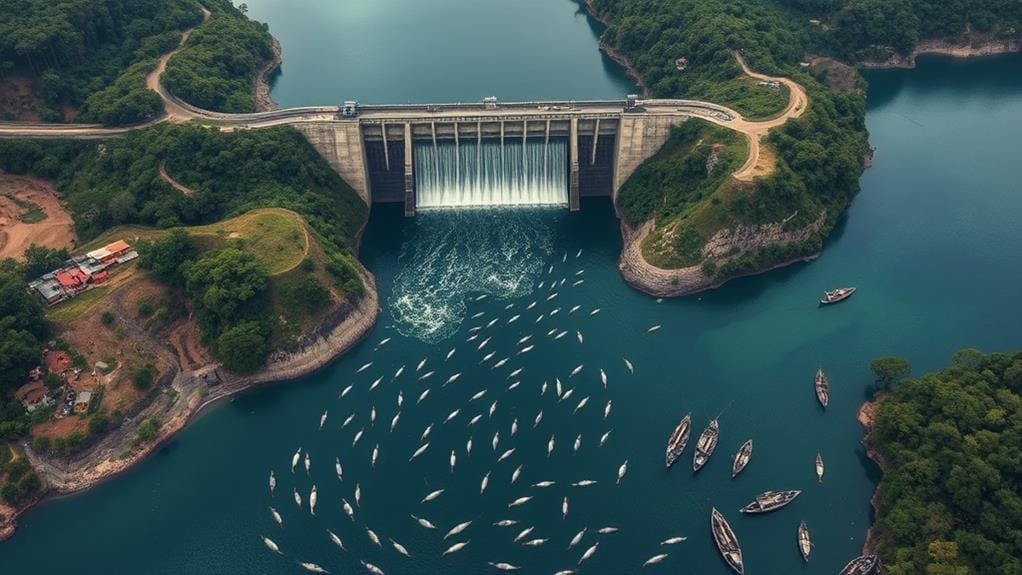
Often, we overlook the economic viability concerns tied to large hydropower projects. The average cost overruns of 96% highlight significant planning errors and potential corruption, undermining the supposed financial benefits of hydropower development. Furthermore, maintenance costs frequently surpass the income generated from energy production, raising doubts about long-term sustainability. While these projects promise renewable energy, the reality is that many local communities remain disconnected from the benefits, as energy is often monopolized and exported. Additionally, the construction and operation of these dams contribute to greenhouse gas emissions, challenging the narrative of hydropower as a climate-friendly option. Ultimately, the economic costs associated with community displacement and environmental degradation often outweigh any projected financial gains, prompting us to reevaluate such initiatives critically.
Biodiversity and Ecosystem Health
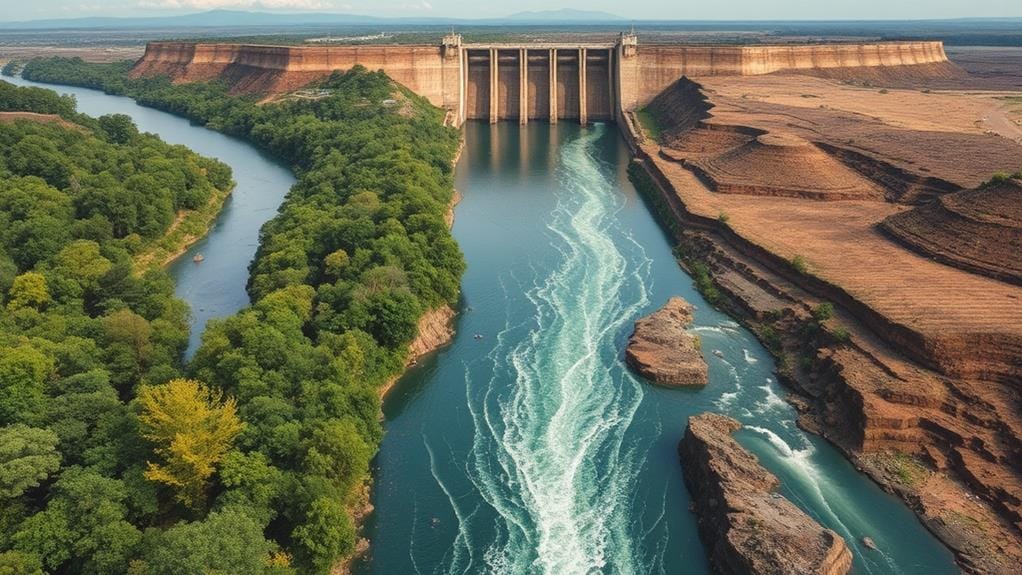
As we examine the impact of hydroelectric dams on biodiversity and ecosystem health, it's essential to recognize how these structures disrupt natural habitats and alter water flow dynamics. The obstruction of migratory pathways not only jeopardizes fish populations, such as salmon and shad, but also leads to a cascade of ecological changes that can diminish overall biodiversity. In addition, the alteration of sediment and nutrient transport can degrade water quality, ultimately threatening the delicate balance of riverine ecosystems that countless species depend on for survival.
Disruption of Natural Habitats
Over time, the construction of hydroelectric dams has considerably disrupted natural habitats, posing serious challenges to biodiversity and ecosystem health. These dams block sediment and nutrient flow, which are essential for the sustenance of aquatic ecosystems, leading to a decline in biodiversity. Migratory fish populations are particularly affected, as dams obstruct their natural spawning routes, diminishing species that rely on these migrations. Additionally, the flooding caused by dam construction results in the loss of critical habitats, such as forests and wetlands, further exacerbating biodiversity loss. Existing dams fragment tributary networks, threatening fish habitats in major river basins, particularly in the Andean Amazon region. Moreover, reservoirs create stagnant water conditions that can lead to harmful algae blooms, negatively impacting water quality and aquatic life.
Altered Water Flow Dynamics
Hydroelectric dams fundamentally change water flow dynamics, and these alterations can have far-reaching effects on biodiversity and ecosystem health. The introduction of altered flow regimes disrupts sediment transport, leading to habitat degradation downstream and a reduction in nutrient availability critical for thriving aquatic ecosystems. Moreover, the creation of stagnant reservoirs can elevate water temperatures, fostering harmful algae blooms that adversely impact biodiversity. Additionally, these dams obstruct migratory patterns of essential fish species, like salmon and shad, which depend on natural currents for spawning. Changes in water quality parameters, including oxygen levels and chemical composition, further jeopardize the health of aquatic organisms. Ultimately, such disruptions diminish the ecological functions of floodplains, threatening the survival of numerous plant and animal species.
Alternatives to Hydroelectric Power
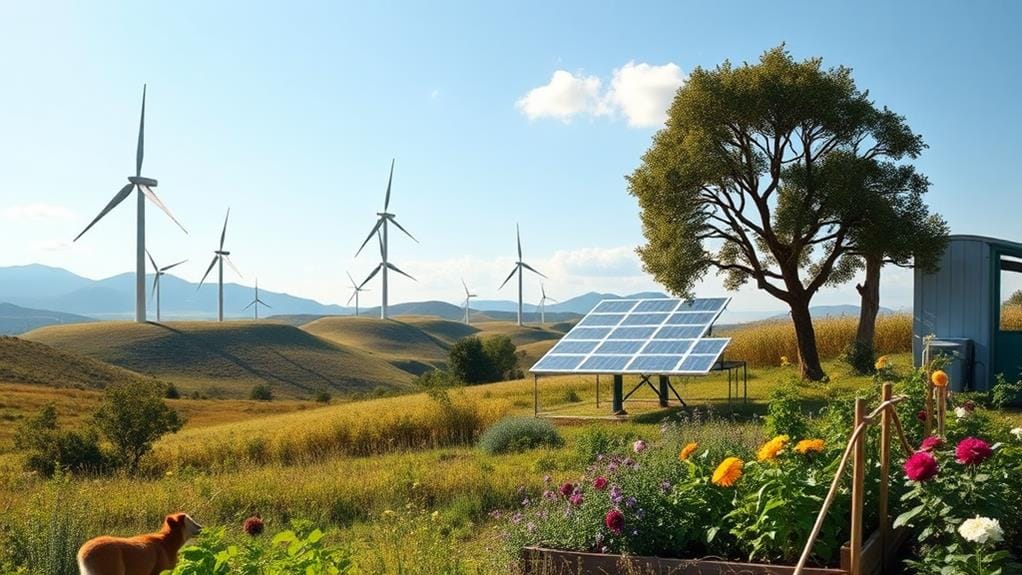
There are several promising alternatives to hydroelectric power that can meet our energy needs while minimizing ecological disruption. Floating solar arrays, for instance, integrate seamlessly with existing water bodies, generating renewable energy without the significant ecological impact associated with dam construction. Additionally, wind energy has demonstrated less detrimental effects on ecosystems compared to hydropower, making it a more sustainable choice for energy generation. Innovations in battery storage technology have further enhanced the affordability and reliability of solar and wind energy, reducing our dependence on hydroelectric systems. Research underscores that prioritizing these renewable energy sources can help preserve essential freshwater ecosystems and protect biodiversity, particularly in sensitive regions, aligning our energy pursuits with ecological stewardship and sustainability.
Frequently Asked Questions
Why Are Hydroelectric Dams Bad for the Environment?
When we ponder hydroelectric dams, we see significant struggles: fish migration falters, sediment transport stifles, water quality wanes, and habitat disruption devastates ecosystems. Together, we must understand these environmental impacts and their lasting consequences.
Why Is Hydropower Controversial?
Hydropower's controversial because it intertwines economic impacts, indigenous rights, and energy policies. We're all concerned about climate change, and while it offers benefits, we can't ignore the significant social and environmental costs it can impose.
What Are the Disadvantages of Hydroelectric Dams?
Imagine a river flowing like a vintage film reel, yet hydroelectric dams disrupt that beauty. They block sediment flow, hinder fish migration, alter water temperature, and cause habitat loss, all affecting our shared environment.
What Are the Negative Effects of Dams on the Environment?
When we think about the negative effects of dams on the environment, we see fish migration blocked, sediment flow disrupted, water temperature altered, and habitat fragmentation that threatens our precious aquatic ecosystems. It's a real concern for all of us.




